Cold Fusion Now! is attending the 21st International Conference on Condensed Matter Nuclear Science ICCF-21 here in Fort Collins, Colorado US. Steve Katinsky and David J. Nagel of LENRIA organized the entire event, working overtime to make this happen. Colorado State University is beautiful and the attendees are happy with the venue.

Yours truly arrived Sunday evening a mere shadow of the woman I was, but after today’s presentations, I’m feeling quite rejuvenated.
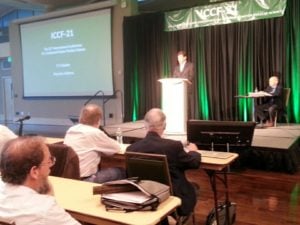 David J. Nagel introduced keynote speaker Tom Darden at the 21st International Conference on Condensed Matter Nuclear Science. He spoke about “group-think” and urged scientists to keep open minds and reject conformity thinking, going through examples of “cultural group-think” in American society, and referenced the last US election. He wants to see the mainstream open up to scientific papers and he is seeking to engage the whole of science in this important field. “Humanity needs for us to succeed,” he ended.
David J. Nagel introduced keynote speaker Tom Darden at the 21st International Conference on Condensed Matter Nuclear Science. He spoke about “group-think” and urged scientists to keep open minds and reject conformity thinking, going through examples of “cultural group-think” in American society, and referenced the last US election. He wants to see the mainstream open up to scientific papers and he is seeking to engage the whole of science in this important field. “Humanity needs for us to succeed,” he ended.
 Michael McKubre followed up making a plea that “condensed matter nuclear science is anomalous no more!” He echoes Tom Darden’s sentiment that CMNS must be integrated into the mainstream of science.
Michael McKubre followed up making a plea that “condensed matter nuclear science is anomalous no more!” He echoes Tom Darden’s sentiment that CMNS must be integrated into the mainstream of science.
“I needed to see it with my own eyes to believe that it was true”, says McKubre. “At the same time, cold fusion is reproduced somewhere on the planet every day. Verification has already happened. But self-censorship is a problem in the CMNS field. Are we guarding our secrets for fear that someone else might take credit? Yes.”
But energy is a primary problem and you must “collaborate, cooperate, and communicate”, McKubre says to the scientists in the room.
McKubre thanked Jed Rothwell and Jean-Paul Biberian for all the work on lenr.org and the Journal of Condensed Matter nuclear Science, respectively. Beyond that, the communication in the CMNS field is very poor and needs to be remedied.
He also supports a multi-laboratory approach where reproductions are conducted. Verification of this science has already occurred in the 90s, with the confirmation of tritium, and the heat-helium correlation. He believes that all the many variables must be correlated to move forward. Unfortunately, he believes the same thing he said in 1996, according to a Jed Rothwell article, that “acceptance of this field will only come about when a viable technology is achieved.”
To make progress, a procedure for replication must be codified, and a set of papers should be packaged for newbies to the field. A demonstration cell is third important effort to pursue.
Electrochemical PdD/LiOD is already proven, despite the problem with “electrochemisty”, and has not been demonstrated for >10 years. Energetics Technologies cell 64 a few years back gave 40 kJ input 1.14 MJ output, gain= 27.5 Sadly, the magic materials issue prevented replication.
“1 watt excess power is too small to convince a skeptic, and 100 Watts too hard (at least for electrochemistry)”, said McKubre. The goal is to create the heat effect at the lowest input power possible.
According to McKubre, Verification, Correlation, Replication, Denomstration, utilization are the five marks of exploring and exploiting the FPHE.
 Afterwards, Edmund Storms of Kiva Labs commented about an important replication in 1990 when he used a piece of palladium from Akito Takahashi that had given excess heat, and Storms got excess heat, too. More material was manufactured using the same exact process, and again that mateerial gave excess heat.
Afterwards, Edmund Storms of Kiva Labs commented about an important replication in 1990 when he used a piece of palladium from Akito Takahashi that had given excess heat, and Storms got excess heat, too. More material was manufactured using the same exact process, and again that mateerial gave excess heat.

Bob Greenyer of MFMP also gave an example of a replication with Mathieu Valat and published by CMNS.
After a short break, Mahadeva Srinivasan introduced the next speaker for the session on Heat Measurements. Dennis Letts began his talk on Building & Testing a High Temperature Seebeck Calorimeter written by D. Letts and D. Cravens.
Letts reported excess heat of 5-7 Watts from this system and gave detailed specifics on the construction, justifying each design element for the experiment. The Seebeck performance is very slow, but stable. The experimental results were then presented by Dennis Cravens.
These guys have control, off and on excess heat regulated by adding light hydrogen to their deuterium fuel, which quenches their excess. 5-7 Watts can be achieved for weeks on end, however, 3-5 Watts is their average. They saw a max of 10 Watts. On the longest run, they achieve 1.58 MJ of energy, “definitely not chemistry”, says Cravens.
Next up was Tadahiko Mizuno’s presentation on Excess Heat Generation by Simple Treatment of Reaction Metal in
Hydrogen Gas. Mizuno was not able to attend, so co-author Jed Rothwell
He reported 20-40 Watts from a glow discharge set-up which uses air-flow calorimetry as other calorimetries interfered with the experiment. Calorimetry is based on the input and output temps, but it is important to measure temperature everywhere, inside the cell, on the reactor, etc.
The reactor design allows viewing the plasma when operational. The cell usines palladium rods and two cells are used simultaneously with one used as an active cell, the other is the control.
Experimental steps were detailed where 99% input power was accounted for, with one experiment giving 6% excess heat and another 12% excess. Rothwell ended the talk by saying anyone who wants to replicate Mizuno’s results will find him to be very helpful, though a translator may be needed.
The last paper for the excess heat session was from George H. Miley of UIUC and LENUCO, who presented Progress in Cluster Enabled LENR by himself and the IH C-U Lab Team.
Miley described his original 12 nanometer thin-film work which he says created dislocation loop clusters. He found that high-loading and de-loading of the reactor creates defects and clusters which will be reactive.
Now he’s working on PdZrO2 nanoparticles 30% Pd / 70% zirconium which produce the defects needed for reaction. A particular milling process produces more defects as measured by an NMR spectrum. The calorimeter uses a pulsed pressurization/depressurization experiments. He showed experimental results of system runs over six months, which he carefully noted did not included some runs where errors or equipment problems occurred.
All the studies were focused on the effect of changing parameter, as opposed to reproducibility. Cryo-milled particles produced higher energies on the order of 600-1200 MJ.
Further study on transmutation by-products were hampered by the possibility of contamination. Also, CR-39 images showed a direct relationship between particle object detection and pressure cycling; more pressure cycles created substantially more particles.
Assuming results remain encouraging in added experiments, a prototype pulse reactor of 1-20W level is possible, if desired. A small 29 grams can produce 30-some Watts power, though there is a scaled up design as well.
 After a lunch break, Robert Duncan introduced Akito Takahashi from Technova, Inc to begin the session on Heat from Nanomaterials with his paper Research Status of Nano-Metal Hydrogen Energy. Results from the MHE reactor was presented.
After a lunch break, Robert Duncan introduced Akito Takahashi from Technova, Inc to begin the session on Heat from Nanomaterials with his paper Research Status of Nano-Metal Hydrogen Energy. Results from the MHE reactor was presented.
2-8 Watts of Anomalous Heat Effect lasted for over a week at elevated temperature using light-hydrogen.
The largest excess heat level was 10-20Watts of excess power for one week. In one run, a big heat burst occurred during desorption of hydrogen. About 15cc100g PNZ5r power and D2 produced heat well beyond chemical energies.
He found an optimum ratio of Pd/N for the PNZ series at 450 degree to be around 7.
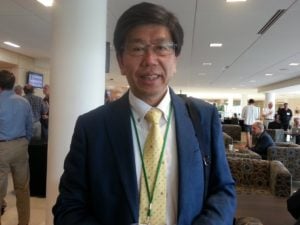 Next up was Yasuhiro Iwamura with Research Center for Electron Photon Science at Tohoku University. He described a collaborative research Project including Kobe University, Tohoku University, Kyushu University, Ngoya University, Technova, and Nissan from 2015-2017 with the objective to verify the existence of the AHE in nanometal and hydrogen gas interaction and to seek controlability of the effect.
Next up was Yasuhiro Iwamura with Research Center for Electron Photon Science at Tohoku University. He described a collaborative research Project including Kobe University, Tohoku University, Kyushu University, Ngoya University, Technova, and Nissan from 2015-2017 with the objective to verify the existence of the AHE in nanometal and hydrogen gas interaction and to seek controlability of the effect.
A table showing 16 experiments using different materials showed multiple instances of high energy with one run creating 200 MJ/mole D. Released Energy per fuel unit (J/g) was shown to be significantly larger than chemical energy.
His experimental setup uses oil flow calorimetry at High Temperature, uses lots of meaurement points, and is resistant to exterior (outside) temperature changes. Sample preparation uses melt spinning. The reactor consists of 1 mm Zirconia beads (about 1300 grams) in the chamber and then the nano material is added.
Experimental results at Tohoku were reproduced at Kobe University with positive results using the very same samples. Temperatures for these runs ranged from 140 degrees C up to 350 degrees C. For the first CNA5S sample with H2, 67.8 eV/H was produced. The two further runs had increased power. Iwamura showed broken ZrO2 beads after excess heat release “which suggests very large local heat stress” in the vicinity of those beads.
Excess heat at Kobe and Tohoku had similar output values, with the same level of power and energy were obtained in their reproduction.
In summary, anomalous heat (more than several MJ/mol-H(D)). was observed for all the samples at elevated temperature, except for the Pd-only nanoparticales.
Tatsumi Hioki presented XRD and XAFS Analyses for Metal Nanocomposites Used in
Anomalous Heat Effect Experiments who also presented results on the 16 collaborative experiments performed. The three samples that did not show excess heat, he said were manufactured at a different location than the other 13 samples that did show excess heat. One of the samples provided 25x excess power at 250-350 degrees.
Hioki says the Pd single element nano particel are not good, and did not provide excess. Ni based alloy nano particles fared much better. “Matrix oxide” either ZrO2 or SiO2 was good to use at temperatures of 150-400 degrees C.
He described succeeding in loading nano palladium into zeoloite pores. For one sample, excess heat was over 10 Watts, and maxed at 65 Watts, lasting for 45 days.
For the ZPZ6 sample the nickel to palladium ratio was 10:1. He showed how temperature makes the various phase changes of PNZ6. “Abundant vacancy formation and a high flux hydrogen migration on the surface of Ni based alloy nano particle may enhance the probability of the 4-body H or D fusion reaction as proposed by Akito Takahashi”, says Hioki.
A short break and then Sunwon Park led the first Theory session by introducing Peter Hagelstein and his presentation on Phonon-Mediated Excitation Transfer Involving Nuclear Excitation.
“Is there anything happening in the phonon space that you can actually see?”, asks Hagelstein. “Yes”, he responds, “with excitation transitions”.
He can interpret of energetic nuclear products in low-level nuclear emission from F&P experiment as due to excitation transfer. Also, there are many excitation transfers while maintaining coherence leads to energy exchange.
We have scheduled Hagelstein for a podcast interview this summer, and we’ll get more on this in layman’s terms then. (I hope!)
Science “light” (not) continued with Vladimir Vysottski who discussed Using the Method of Coherent Correlated States for Realization of Nuclear Interaction of Slow Particles with Crystals and Molecules. These theories are highly-mathematical and contain ideas from quantum mechanics such as superposition states and tunneling. Coherent correlated states are thought to allow the tunneling effect to occur, and a reaction to take place. I would suggest readers listen to Vysottski’s podcast and hear what he is talking about yourself.
Continuing on the theory tip was Anthony Zuppero and Thomas Dolan presenting Electron Quasiparticle Catalysis of Nuclear Reactions. He predicated his presentation by saying “this is work done outside of LENR, but contains information of interest to the LENR community”.
Taking two particles, each has a potential. At some point when they are a particular distance, they begin to couple, and an “big” electron is ejected out of the system leaving the reactant in a low-energy state. This mainstream research was published in 2011.
There was a lot more from Zuppero and I have planned a podcast for this summer with these authors to get the lowdown in layman’s terms, so look for that then.
The final paper on theory was given by Norman Cook on The “Renaissance” in Nuclear Physics:
Low-Energy Nuclear Reactions and Transmutations. He started with his Conclusion and worked backwards saying “a new level of spatial detail concerning nuclear structure has become possible” called NLEFT. This is based on work done by Ulf Meissner, et al.
Conventional Lattice QCD is not the same as NLEFT by Meissner, for was awarded the Lise Metner Prize in Nuclear Physics for theoretical work in 2016. New discoveries are incompatible with the Bohr interpretation of QM.
After that, my head was spinning. I wasn’t able to get much video or audio, but I made a lot of contacts for future podcasts to be conducted this summer, and boy do we have line-up. All the scientists are having some drinks and conversation now, and getting ready for tomorrow’s presentations on Heat, Transmutions, Theory, and Rydberg Matter.
I’m off to get a few more photos. Here’s few pics from today:
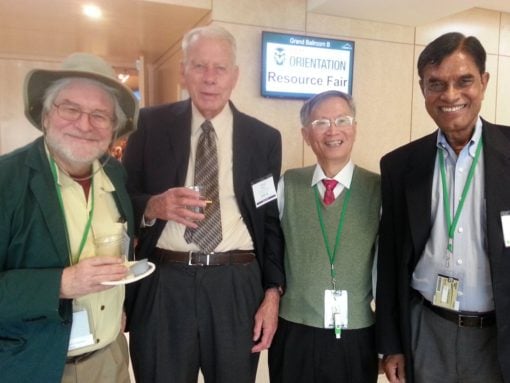


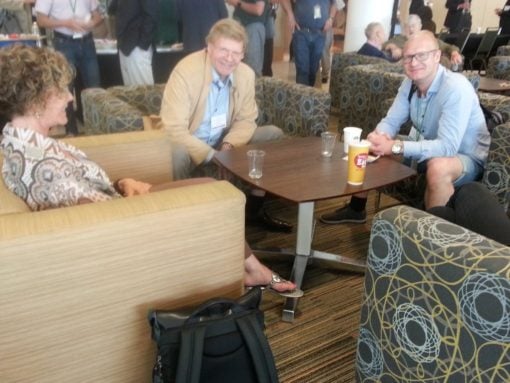
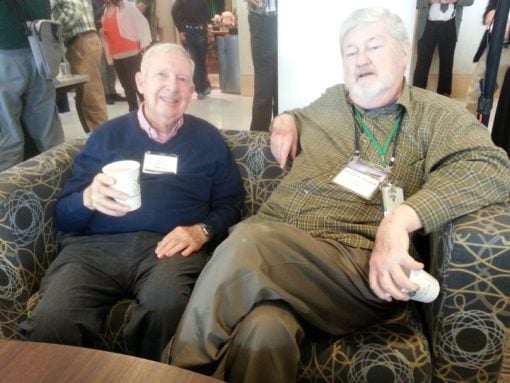
 The sixteenth episode of the Cold Fusion Now! podcast features Dr. Pamela Mosier-Boss, an analytical chemist who spent a career working at the Navy’s SPAWAR laboratory developing environmental sensors and working on LENR.
The sixteenth episode of the Cold Fusion Now! podcast features Dr. Pamela Mosier-Boss, an analytical chemist who spent a career working at the Navy’s SPAWAR laboratory developing environmental sensors and working on LENR. Patreon is a platform for supporting creators. You can pledge as little as a dollar per episode and cap your monthly spending. When we deliver, you reward the work!
Patreon is a platform for supporting creators. You can pledge as little as a dollar per episode and cap your monthly spending. When we deliver, you reward the work! 


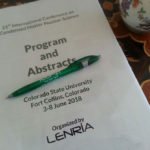
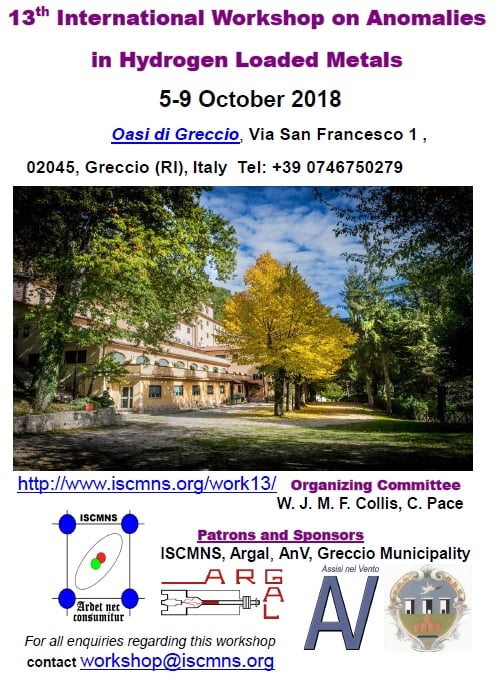
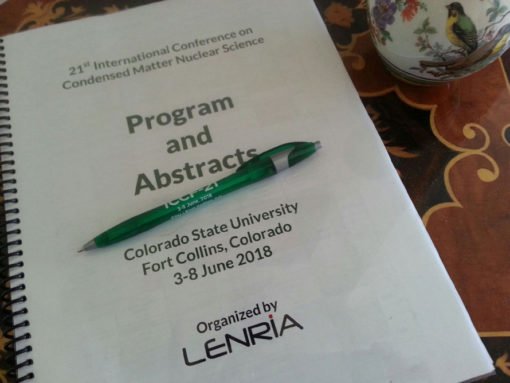













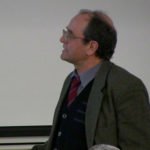 Dr. Vladimir I. Vysotskii is a Nuclear Physicist and Head of Theoretical Radiophysics Department at Kiev National Shevchenko University, Ukraine. He received a Ph.D. in Theoretical Physics from Kiev Institute of Theoretical physics, and a second Doctorate in Theoretical and Solid State Physics. His areas of research and applications is wide, from lasers to bio-physics.
Dr. Vladimir I. Vysotskii is a Nuclear Physicist and Head of Theoretical Radiophysics Department at Kiev National Shevchenko University, Ukraine. He received a Ph.D. in Theoretical Physics from Kiev Institute of Theoretical physics, and a second Doctorate in Theoretical and Solid State Physics. His areas of research and applications is wide, from lasers to bio-physics. 